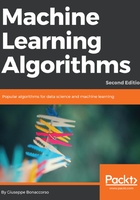
Predictive analysis
The goal of machine learning is almost related to this precise stage. In fact, once we have defined a model of our system, we need to infer its future states, given some initial conditions. This process is based on the discovery of the rules that underlie the phenomenon so as to push them forward in time (in the case of a time series) and observe the results. Of course, the goal of a predictive model is to minimize the error between actual and predictive value, considering all possible interfering factors.
In the example of the large store, a good model should be able to forecast a peak before a day off and a normal behavior in all the other cases. Moreover, once a predictive model has been defined and trained, it can be used as a fundamental part of a decision-based process. In this case, the prediction must be turned into a suggested prescription. For example, the object detector of a self-driving car can be extremely accurate and detect an obstacle on time. However, which is the best action to perform in order to achieve a specific goal? According to the prediction (position, size, speed, and so on), another model must be able to pick the action that minimizes the risk of damage and maximizes the probability of a safe movement. This is a common task in reinforcement learning, but it's also extremely useful whenever a manager has to make a decision in a context where there are many factors. The resultant model is, hence, a pipeline that is fed with raw inputs and uses the single outcomes as inputs for subsequent models. Returning to our initial example, the store manager is not interested in discovering the hidden oscillations, but in the right volumes of goods that he has to order every day. Therefore, the first step is predictive analysis, while the second is a prescriptive one, which can take into account many factors that are discarded by the previous model (that is, different suppliers can have shorter or longer delivery times or they can apply discounts according to the volume).
So, the manager will probably define a goal in terms of a function to maximize (or minimize), and the model has to find the best amount of goods to order so as to fulfill the main requirement (that, of course, is the availability, and it depends on the sales prediction). In the remaining part of this book, we are going to discuss many solutions to specific problems, focusing on the predictive stage. But, in order to move on, we need to define what learning means and why it's so important in more and more different business contexts.